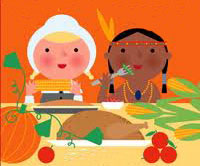Thanksgiving: A Native American View
by Jacqueline Keeler
(retrieved from http://www.tolerance.org/activity/thanksgiving-mourning, adapted)
Directions: read the essay below for the main ideas. Then answer the questions before moving on to the next page.
I celebrate the holiday of Thanksgiving.
This may surprise those people who wonder what Native Americans think of this official U.S. celebration of the survival of early_arrivals in a European invasion that culminated in the death of 10 to 30 million native people.
Thanksgiving to me has never been about Pilgrims. When the Pilgrims came to Plymouth Rock, they were poor and hungry -- half of them died within a few months from disease and hunger. When Squanto, a Wampanoag man, found them, they were in a pitiful state. He spoke English, having traveled to Europe. The Pilgrim's English crops had failed, and he took pity on them. The native people fed them through the winter and taught them how to grow their food.
To the Pilgrims, and most English and European peoples, the Wampanoags were heathens, and of the Devil. They saw Squanto not as an equal but as an instrument of their God to help his chosen people, themselves., Before 20 years passed, European disease and treachery had decimated the Wampanoags. Most diseases then came from animals that Europeans had domesticated. Some diseases spread through gifts of blankets that had been used by sick Europeans. Some estimate that diseases accounted for a death toll reaching 90 percent in some Native American communities. By 1623, Mather the elder, a Pilgrim leader, was giving thanks to his God for destroying the heathen savages to make way "for a better growth," meaning his people.
In stories told by the Dakota people, an evil person always keeps his or her heart in a secret place separate from the body. The hero must find that secret place and destroy the heart in order to stop the evil. I see, in the "First Thanksgiving" story, a hidden Pilgrim heart. The story of that heart is the real tale than needs to be told. What did it hold? Bigotry, hatred, greed, self-righteousness? We have seen the evil that it caused in the 350 years since. Where is the hero who will destroy that heart of evil? I believe it must be each of us. Indeed, when I give thanks this Thursday and I cook my native food, I will be thinking of this hidden heart and how my ancestors survived the evil it caused.
Because if we can survive, with our ability to share and to give intact, then the evil and the good will that met that Thanksgiving day in the land of the Wampanoag will have come full circle.
And the healing can begin.
Jacqueline Keeler, a member of the Dineh Nation and the Yankton Dakota Sioux works with the American Indian Child Resource Center in Oakland, California. Her work has appeared in Winds of Change, an American Indian journal.
According to the essay...
Select the true sentence from the options in the drop-down box
Go to the next essay:
If you have read both essays, move on to the past perfect!
